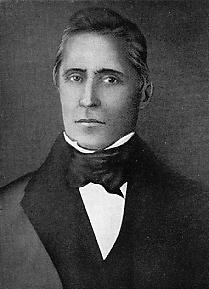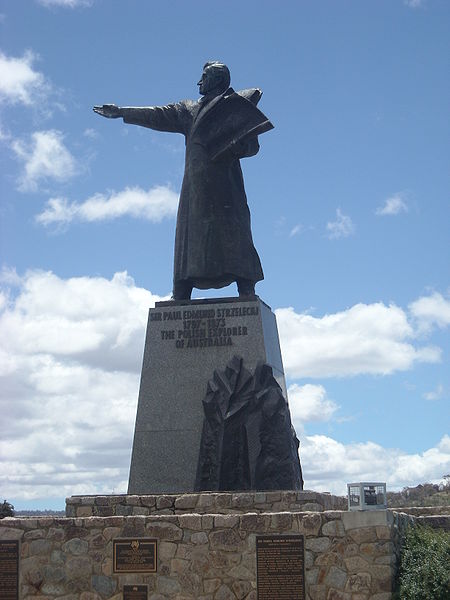<Back to Index>
- Explorer Paweł Edmund Strzelecki, 1797
- Painter Max Liebermann, 1847
- Sultan of the Ottoman Empire Mahmud II, 1785
PAGE SPONSOR


Sir Paul Edmund de Strzelecki KCB CMG FRGS MRS (20 July 1797 – 6 October 1873), was a Polish explorer and geologist.
Strzelecki was born in Głuszyna (then part of South Prussia, today part of the city of Poznań), Greater Poland, in 1797, the third child of Franciszek Strzelecki, an impoverished Polish nobleman (Szlachta) without land or title, and his wife, Anna Raczyńska. In Australia Strzelecki took the title of 'Count', but his parents were not titled and it is not known on what his claim was based. Strzelecki left school without matriculating.
As a requirement of all men with Prussian citizenship, he served in the Prussian army, but did not like the strict discipline and resigned his ensign's commission. His army service provided many opportunities to travel. Not long after, he attempted an elopement with a girl of 15, Adyna Turno, but she was overtaken on the way to their meeting place, and Strzelecki, provided with funds by his family, found it wise to leave the district. He eventually came under the notice of Prince Sapieha, who placed him in charge of a large estate in the Russian occupied part of Poland. He was then about 26 years of age and appears to have carried out his duties successfully. Some years later the prince died, and in 1830 trouble arose between his heir and Strzelecki amid the November Uprising against tsarist Russia. Strzelecki was forced to leave Poland and went to England.
On 8 June 1834 he sailed from Liverpool to New York. He travelled much in North and South America, Cuba, Tahiti and the South Sea Islands, and went to New Zealand probably about the beginning of 1839. He arrived at Sydney on 25 April 1839. At the request of the Governor of New South Wales, Sir George Gipps, he made a geological and mineralogical survey of the Gippsland region in present day eastern Victoria, where he made many discoveries. He discovered gold in
1839, however, Gipps feared the effects of gold on the colony and
persuaded Strzelecki to keep his discovery secret. Later in 1839
Strzelecki set out on an expedition into the Australian Alps and explored the Snowy Mountains with James Macarthur, James Riley and two Aboriginal guides: Charlie Tarra and Jackey. In 1840 he climbed what he thought was the highest peak in Australia and named it Mount Kosciuszko, to honour Tadeusz Kościuszko, one of the national heroes of Poland and a hero of the American Revolutionary War. The mountain he named as Mount Kosciuszko is in fact present day Mount Townsend. The names of the two mountains were swapped by the New South Wales government in 1910. From there he made a journey through Gippsland. After passing the Latrobe River it was found necessary to abandon the horses and all the specimens that had been collected, and try to reach Western Port.
For 22 days they were on the edge of starvation, and ultimately only
saved by the knowledge and hunting ability of their guide Charlie, who
caught native animals which they ate. The party, practically exhausted,
arrived at Western Port on 12 May 1840 and reached Melbourne on 28 May. From 1840 to 1842, based in Launceston, Tasmania (then known as Van Diemen's Land), Strzelecki explored nearly every part of the island, usually on foot with three men and two pack horses. The Lieutenant Governor, Sir John Franklin, and his wife, Lady Jane, afforded him every help in his scientific endeavours. Strzelecki
left Tasmania on 29 September 1842 by steamer and arrived in Sydney on
2 October. He was collecting specimens in northern New South Wales
towards the end of that year, and on 22 April 1843 he left Sydney after
having travelled 11,000 kilometres (7,000 miles) through New South
Wales, Victoria and Tasmania, examining the geology along the way. He
went to England after visiting China, the East Indies and Egypt. In 1845 he published his Physical Description of New South Wales and Van Diemen's Land. He arrived back to London in 1849, where he was made a Fellow of the Royal Geographical Society and awarded a Gold medal for
"exploration in the south eastern portion of Australia". The society
still displays his huge geological map of New South Wales and Tasmania for public viewing. He was also made a member of the Royal Society. He gained widespread recognition as an explorer as well as a philanthropist. Towards the end of 1846, the Great Irish Famine was under way and the British Relief Association formed
with the sum of £500,000 subscribed for the relief of the
sufferers. Strzelecki was appointed an agent to superintend the
distribution of supplies in County Sligo and County Mayo.
He devoted himself to his task with success, though for a time
incapacitated by famine fever. In 1847/48 he continued his work in Dublin as sole agent for the association. In recognition of his services he was made a Companion of the Order of the Bath (CB)
in November 1848. He helped impoverished Irish families to seek new
lives in Australia. He was also active in helping injured soldiers
during the Crimean War (being personally acquainted with Florence Nightingale). He was awarded an honorary degree from the University of Oxford, appointed a Companion of the Order of St Michael and St George (CMG), and knighted as a Knight Commander of the Order of the Bath (KCB). In 1983 he was honoured on a postage stamp depicting his portrait issued by Australia Post.